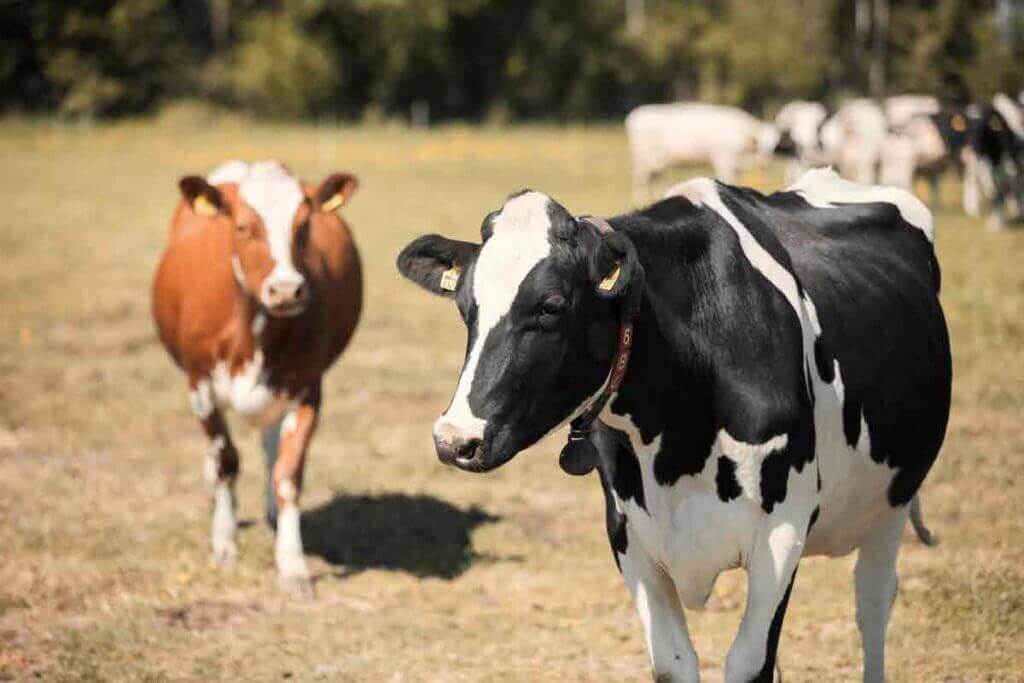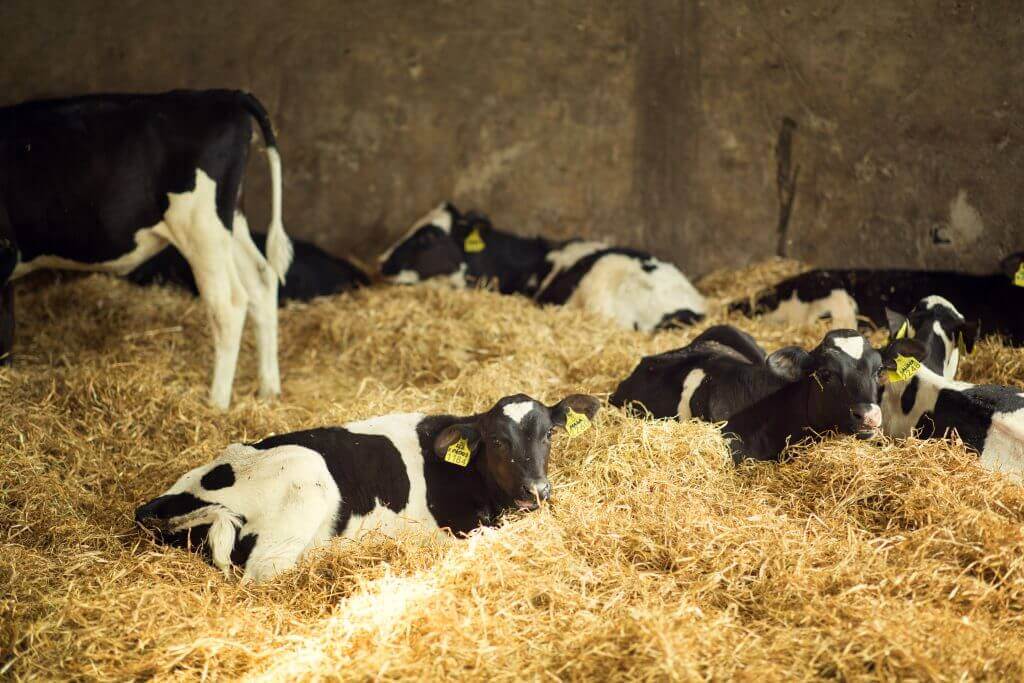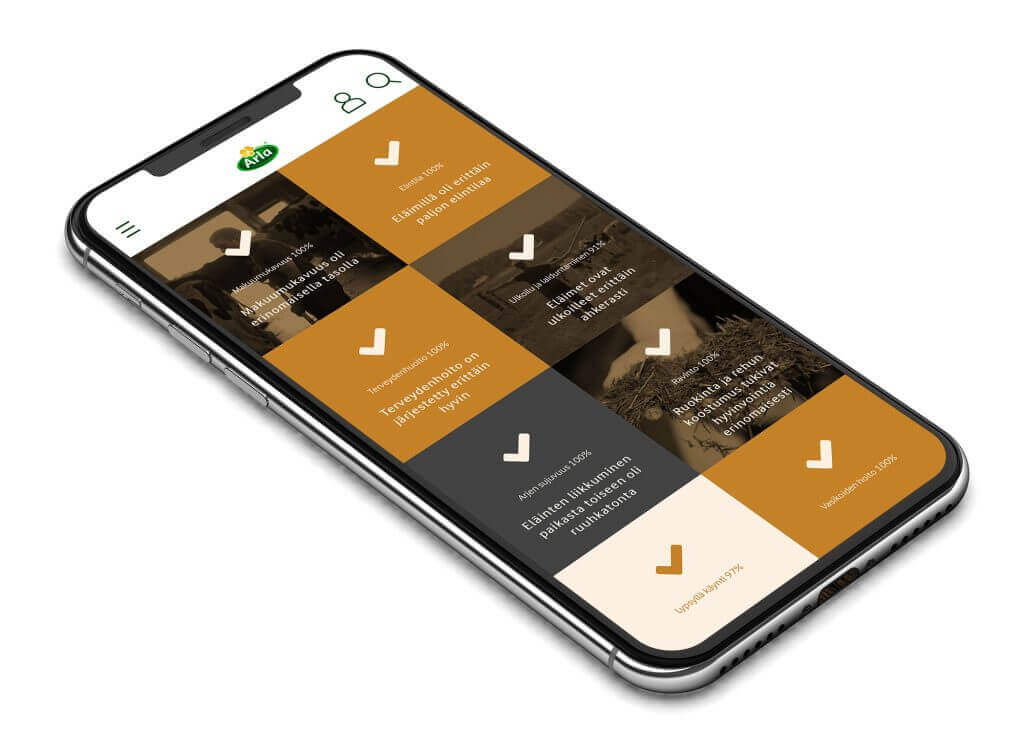
CASE: Arla
AI Application for Monitoring Cow Welfare
The Arla Iris computer vision application, powered by artificial intelligence, provides real-time insights into the well-being of cows. With the app, deviations can be detected immediately and addressed in time.

Arla
AI Application for Monitoring Cow Welfare
The Arla Iris computer vision application, powered by artificial intelligence, provides real-time insights into the well-being of cows. With the app, deviations can be detected immediately and addressed in time.
Arla AI Animal Welfare Monitoring: From Vision to Product
Arla Oy is Finland's second-largest dairy company, part of the international Arla Foods consortium. Arla has approximately 500 milk producers in Finland who produce 220 million liters of milk annually. The healthiness, sustainability, and quality of products are important to Arla.
As one of the world's leading dairy product manufacturers, Arla is aware of its social responsibility and continuously strives to reduce the environmental impacts of production by developing new solutions. Arla wants to make its operations as transparent as possible and openly share information about its production. For over a year now, consumers have been able to follow the "Single Farm Milk" journey from farm to dairy.
Monitoring Cow Welfare
Consumers expect companies to take responsibility for the environment and the welfare of production animals. Responsibility and transparency are especially important for products that are of animal origin. Animal welfare is one significant part of responsibility.
A study conducted by Foodwest in 2018 shows that animal welfare is one of the most critical factors for a responsible dairy company. Consumers consider animal welfare an important part of responsible consumption, but on the other hand, they find it difficult to assess the responsibility of animal-derived products. Some consumers feel distanced from agricultural production and cannot assess the state of animal welfare at all. This makes it difficult to compare products.
Arla encourages its milk producers to develop animal welfare and adopt new practices that improve the quality of life for animals. All Arla producers are committed to following Arla's quality program, and most farms meet even higher Quality Label criteria.
However, caring for animal welfare is not always easy because many farms have a large number of animals and limited staff. Cow welfare improves when free-stall barns are used instead of tie-stalls, but the workload also increases.
In tie-stall barns, where cows are tethered, monitoring cows is easier and health problems can be detected more quickly. In free-stall barns, cows can move freely and on some farms also go outside if they wish. Free-stall barns enable species-typical behavior for cows, but bring other welfare-threatening challenges such as competition at feeding areas or insufficient resting places. Cows living in free-stall barns require more supervision.

Quality Deviations Are a Risk to Brand Value
Although most farms comply well with animal husbandry regulations and the best ones far exceed minimum requirements, regrettable exceptions sometimes occur. For this reason, in addition to official supervision, Arla also monitors farm conditions. If negligence occurs, this is reported to authorities and milk collection from the farm is suspended if necessary. However, negligence is a risk to Arla's brand.
The implementation of animal welfare is essential for Arla, and the quality program created to help producers defines Arla's required minimum standards for animal welfare that farms must follow. The program is simultaneously Arla's quality promise to consumers. When purchasing Arla products, consumers can trust that animal welfare has been properly taken care of. Deviations from the quality program could, in the worst case, collapse consumer trust and significantly reduce brand value. For this reason, conducting our own monitoring measures is extremely important.

Single Farm Milk: From Vision to Finished Product
Arla's original vision was to build the world's most transparent milk chain using technology. The vision was based on the goal of solving a concrete problem experienced by consumers, in this case answering the question of where food comes from and who produced it. In spring 2018, Arla chose Empirica as a cooperation partner to develop the world's most transparent milk chain and bring the needed technological expertise to the project.
"The supplier choice was clear from the first meeting. Empirica knew how to approach the matter comprehensively and offered a solution while challenging our vision well throughout the project. The project succeeded well and we continue the well-started cooperation with Empirica."
Tomi Sirén
Head of Digital and Technological Innovation, Arla
In cooperation with growth marketing company Truly Agency, the Arla Milk Chain was launched in autumn 2018, which opens up the milk's journey from farm to dairy for consumers. The pilot farm chosen was Tikka's organic dairy farm in Kurikka. Through this solution, Arla wanted to provide consumers with more information about milk production and thereby increase consumer trust. Consumers have the right to know how the product was made and what conditions prevail on the farm.
From these starting points began the Arla Iris project. Consumers had already been able to follow the milk's journey from farm to dairy on Arla's website for several months. In Arla's own consumer surveys, in addition to origin information, consumer concerns about animal welfare had emerged. The most logical step was therefore to choose animal welfare as the next development target in improving milk chain transparency.
Development of the Arla Iris Application
For this purpose, we developed the Arla Iris application, an innovative solution that combines various data sources and an advanced AI algorithm that follows the daily life of dairy farms and continuously monitors and analyzes the most critical indicators of animal welfare. Finally, the data is stored in Arla Milk Chain, a customized blockchain through which production data can be reliably linked to individual milk packages and opened to consumers. Both animal welfare experts and consumers were involved in the development work. This ensured the relevance and interest of the measured data.
Measuring animal welfare is challenging and requires abundant data and a more complex calculation system than, for example, temperature measurement. The measurement was decided to be implemented on the previous pilot farm, Tikka's farm. Tikka's farm is an organic dairy farm where cows live in a free-stall barn. Cows can move freely in indoor and outdoor areas and go to milking when they want. With the help of experts, it was determined what kind of indicators could be used to measure cow welfare. Ready-made data was available very limitedly, so it was clear that more data would be needed. At this stage, it was already clear that we would need new data points to obtain sufficient amounts of data. First, however, it had to be decided what to measure.
"It's important for people to get assurance that on dairy farms, cows live in a species-typical way and are well cared for. We wanted to open up to consumers in the already familiar Arla Milk Chain a new kind of opportunity to follow the conditions of cows exactly as they really are. The dairy farm can also utilize AI-compiled information in developing its own operations."
Kai Gyllström
CEO, Arla
AI Helps Identify Anomalies
In cooperation with welfare experts and consumers, we mapped all factors significant for animal welfare and selected those that best suit automatic measurement in the challenging barn environment. The characteristics chosen for measurement were outdoor grazing, lying comfort, daily routine smoothness, milking visits, living space, healthcare, nutrition, and calf care.

The barn conditions made utilizing computer vision particularly challenging. There was considerably more dust than in typical application environments, the amount of light was sometimes nonexistent and sometimes excessive. Camera placement was restricted by barn structures such as pipes and network connection coverage. Due to limited connections, images are analyzed in cameras, keeping data transfer amounts low. Only the analysis result is stored in Arla Milk Chain. The implementation faced its own challenge from curious cows, who naturally as curious animals immediately came to examine the new cameras installed in the barn.
When these issues were resolved and image quality was made sufficiently high, the actual calculation model could be built. Animals and their behavior were identified from camera images and monitored. Based on this, selected calculation models calculate the values of chosen indicators.
"Cow welfare consists of fairly simple things like eating and the opportunity to rest comfortably. I particularly pay attention to cows' lying comfort, proper nutrition, and cow health. By utilizing AI and monitoring through cameras, abundant information complementing human observation can be obtained from cows throughout the year. The advantage is also that deviations can be detected quickly with cameras."
Essi Wallenius
CEO, Armenta Benessi
Computer Vision Is a Tireless Assistant
Traditionally, dairy farm monitoring is based on supervision by external experts and authorities. However, these monitoring visits are not sufficient to ensure the implementation of animal welfare, but we additionally need reliable daily information about animal conditions. However, we did not want to increase the workload of dairy farm personnel, so only an automated solution was feasible. Through the developed application, cow welfare can be analyzed quickly and reliably, which eases the work of farm personnel. Additionally, the accumulated data can be utilized in the future for various purposes such as automatic alerts, reports offered to producers, or production optimization.
"We have always strived to do more than what is required of a dairy farm in Finland to ensure animal welfare. Arla's developed technology will not replace the monitoring done by welfare experts, veterinarians, and our personnel in the future either, but it can strengthen the whole, and most importantly – improve Finns' understanding of how dairy farms operate and what factors affect cow welfare."
Tuomo Mäkinen
Tikka farm entrepreneur
Small Steps Toward a Big Goal
Arla took a conscious risk when deciding to open real-time information about animal welfare to consumers. This is part of the radical transparency goal, which aims to increase consumer trust in Arla's production.
However, the risk-taking paid off and Arla received positive attention from both consumers and media, which in part encourages Arla to strive toward even more open and responsible production in the future. When a big vision is broken into small entities, risks also remain small and the final whole is completed piece by piece.